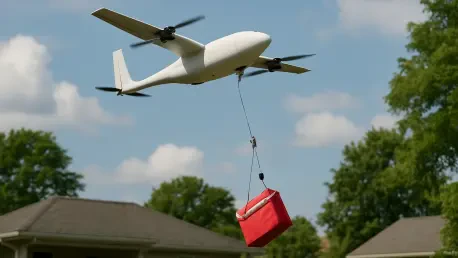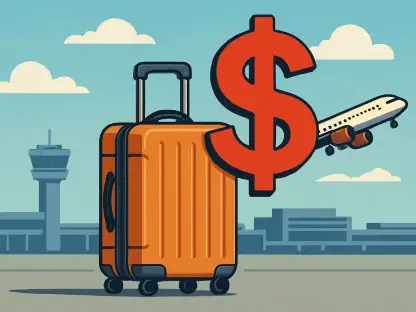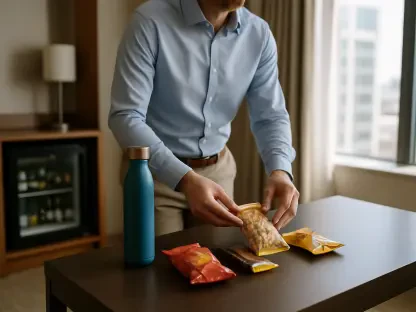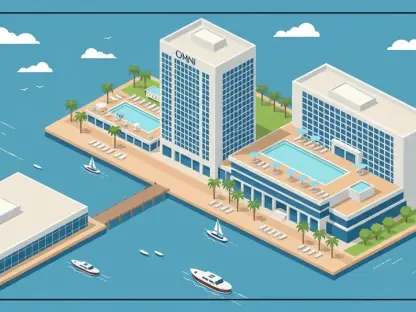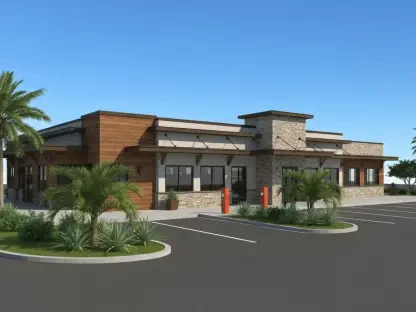Imagine a world where your favorite meal arrives at your doorstep in mere minutes, flown directly to your backyard by a silent, zero-emission aircraft, bypassing traffic and traditional delivery delays. This scenario is no longer a distant dream but a reality in select areas of Dallas, thanks to Zipline’s innovative aerial delivery technology. As a pioneer in autonomous logistics, Zipline is reshaping the last-mile delivery landscape, transitioning from critical medical supply missions to consumer food delivery. This review delves into the intricacies of Zipline’s system, exploring its features, real-world impact, and potential to revolutionize how goods reach consumers.
Unveiling Zipline’s Autonomous Delivery System
Zipline has emerged as a leader in physical AI for commercial logistics, initially focusing on delivering medical supplies to remote regions. The technology, which began with life-saving missions in rural hospitals, has now expanded into urban settings with consumer-focused applications like food delivery. This shift demonstrates Zipline’s adaptability in addressing diverse logistical challenges, from healthcare access to everyday convenience.
The significance of this technology lies in its ability to tackle pressing issues such as delivery speed and environmental impact. By utilizing autonomous aircraft, Zipline reduces reliance on traditional vehicle-based delivery, cutting down on carbon emissions and traffic congestion. In a world increasingly focused on sustainability, this approach positions the company as a key player in the broader technological ecosystem.
Moreover, Zipline’s evolution reflects a growing trend toward automation in logistics. The transition from niche medical deliveries to mainstream consumer services highlights how advanced robotics and AI can bridge gaps in accessibility, offering solutions that are both efficient and scalable. This sets the stage for a deeper exploration of the system’s capabilities and applications.
Key Components of Zipline’s Delivery Technology
Design and Navigation of Autonomous Zips
At the heart of Zipline’s system are its autonomous aircraft, known as Zips, engineered for precision and reliability. These compact drones are designed to navigate complex environments, autonomously avoiding obstacles and ensuring accurate deliveries. Their advanced navigation systems enable them to operate seamlessly in urban and rural settings alike.
A standout feature of Zips is their remarkably quiet operation, making them barely noticeable during flight. This is particularly beneficial in densely populated areas where noise pollution is a concern. Additionally, the aircraft are built to withstand various weather conditions, from rain to intense heat, ensuring consistent performance regardless of external factors.
The design of Zips prioritizes both functionality and safety. Their ability to travel directly to specific locations, such as a customer’s home or a public park, showcases a level of precision that sets Zipline apart from traditional delivery methods. This capability is a cornerstone of their effectiveness in last-mile logistics.
Innovative Delivery Process and Payload Management
Zipline’s delivery mechanism is as ingenious as its aircraft design, featuring a unique process that ensures safe and accurate drop-offs. Orders are loaded into a Zipping Point, a designated hub where Zips autonomously retrieve packages. From there, the aircraft fly to the delivery location, hovering at approximately 300 feet to lower the package gently to the ground.
The system currently supports a payload capacity of up to 5.5 pounds, with plans to increase this to 8 pounds in the near future. This capacity is sufficient for most food delivery orders, and built-in insulation ensures that items remain fresh during transit. Such features are critical for maintaining quality, especially in the competitive food delivery market.
Safety and precision are evident in every step of the process. The hovering descent minimizes risks to people and property below, while the autonomous nature of the operation reduces human error. This streamlined approach not only enhances efficiency but also redefines customer expectations for delivery speed and reliability.
Latest Developments and Strategic Collaborations
Zipline’s recent advancements have brought its technology into the consumer spotlight, most notably through a partnership with Chipotle to launch the Zipotle program in the Dallas area. This collaboration marks a significant step into ultra-fast food delivery, with select customers in Rowlett, Texas, gaining early access to the service. The program showcases how aerial delivery can transform the dining experience.
Operationally, Zipotle functions through the Zipline app, available on both Apple and Android platforms, allowing eligible users to place Chipotle orders for aerial delivery. The service currently operates from 12 p.m. to 8 p.m. daily, with plans to extend hours to 10 p.m. soon. This initial rollout provides valuable insights into consumer behavior and system scalability in a real-world setting.
The partnership underscores a shared commitment to innovation and sustainability. By combining Chipotle’s focus on fresh, responsibly sourced food with Zipline’s efficient, zero-emission delivery model, Zipotle offers a glimpse into the future of food logistics. This collaboration could pave the way for similar alliances with other consumer brands, expanding the reach of aerial delivery.
Practical Applications and Broader Impact
Zipline’s technology has proven its worth across diverse applications, starting with medical deliveries to over 5,000 hospitals and health facilities worldwide. The ability to reach remote or underserved areas with critical supplies has saved countless lives, establishing the company as a trusted name in healthcare logistics. This foundation of reliability underpins its expansion into other sectors.
In the consumer space, the Zipotle initiative highlights Zipline’s potential to redefine food delivery. The system’s capacity to serve hard-to-reach locations, such as backyards or public parks, enhances accessibility and convenience. Customers no longer need to be tied to traditional delivery points, opening up new possibilities for where and how meals are enjoyed.
Beyond individual benefits, Zipline’s impact extends to industry-wide trends. By integrating autonomous delivery into everyday life, the technology addresses urban challenges like traffic congestion and environmental pollution. This broader influence suggests that aerial delivery could become a standard in logistics, reshaping expectations for speed and sustainability in multiple sectors.
Obstacles and Areas for Improvement
Despite its promise, Zipline’s aerial delivery system faces several challenges that could affect its widespread adoption. Regulatory hurdles remain a significant barrier, as drone operations are subject to strict airspace rules that vary by region. Navigating these legal complexities requires ongoing collaboration with authorities to ensure compliance and safety.
Scalability presents another concern, particularly as Zipline aims to expand beyond limited areas like Dallas. Expanding coverage to larger regions or increasing delivery frequency demands significant investment in infrastructure and fleet capacity. Additionally, consumer adoption may be slow, as some may hesitate to embrace drone delivery over familiar ground-based methods.
Safety considerations and competition also loom large. While Zipline prioritizes secure operations, public perception of drones overhead could raise concerns. Meanwhile, traditional delivery services and emerging competitors in the drone space challenge market share. Addressing these issues through technological upgrades and public education will be crucial for long-term success.
Prospects for Zipline’s Growth and Innovation
Looking ahead, Zipline’s technology holds immense potential for expansion and refinement. Plans to extend operations beyond Dallas signal an ambition to reach more urban and suburban markets over the coming years. This growth could redefine last-mile delivery on a national scale, making aerial logistics a common sight.
Innovations in payload capacity and application diversity are also on the horizon. Increasing the weight limit to 8 pounds will accommodate a wider range of orders, while exploring sectors beyond food—such as retail or emergency supplies—could broaden the system’s utility. These advancements would further cement Zipline’s role as a versatile logistics provider.
The long-term vision includes significant environmental benefits, as zero-emission deliveries contribute to sustainability goals. If aerial delivery becomes normalized, it could reduce the carbon footprint of logistics worldwide. This future, while ambitious, hinges on overcoming current limitations and fostering public trust in autonomous systems.
Final Thoughts and Future Directions
Reflecting on the journey of Zipline’s aerial delivery system, it is evident that the technology has already achieved remarkable milestones, with over 1.6 million deliveries completed in 2025. Its transition from medical missions to consumer applications like Zipotle demonstrates a versatility that few competitors match. The system’s precision, sustainability, and innovative approach have positioned it as a frontrunner in autonomous logistics.
Moving forward, stakeholders should focus on strategic partnerships to accelerate adoption, much like the collaboration with Chipotle that opened new markets. Investment in public awareness campaigns could also address hesitancy around drone technology, emphasizing safety and benefits. Additionally, advocating for streamlined regulations would facilitate expansion into diverse regions and industries.
Ultimately, the next steps for Zipline involve balancing innovation with practicality, ensuring that technological advancements align with consumer needs and societal readiness. Exploring integrations with smart city initiatives could further enhance efficiency, embedding aerial delivery into urban planning. These efforts promise to sustain Zipline’s momentum, driving a future where instant, eco-friendly delivery is no longer an exception but the norm.
